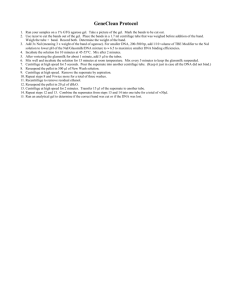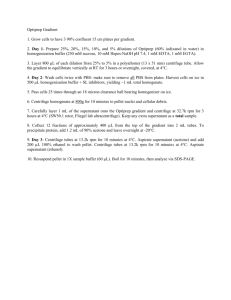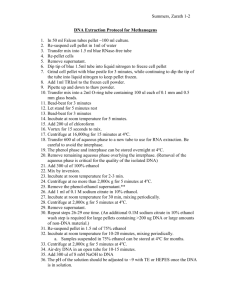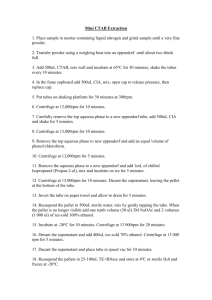RFmaxiprep
advertisement
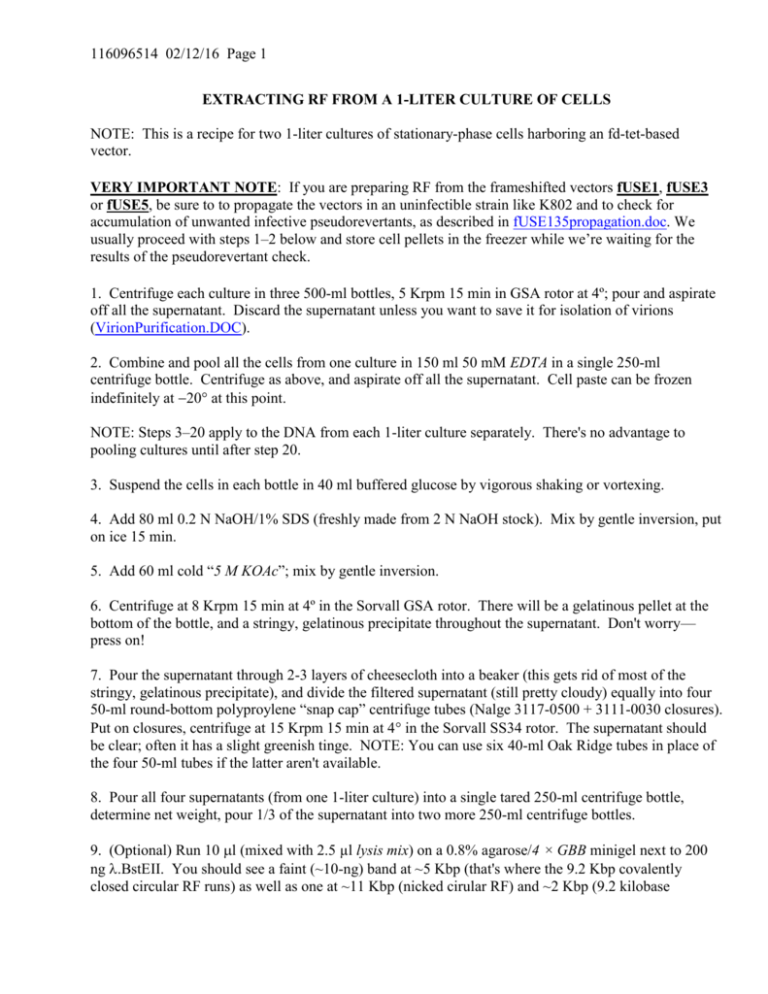
116096514 02/12/16 Page 1 EXTRACTING RF FROM A 1-LITER CULTURE OF CELLS NOTE: This is a recipe for two 1-liter cultures of stationary-phase cells harboring an fd-tet-based vector. VERY IMPORTANT NOTE: If you are preparing RF from the frameshifted vectors fUSE1, fUSE3 or fUSE5, be sure to to propagate the vectors in an uninfectible strain like K802 and to check for accumulation of unwanted infective pseudorevertants, as described in fUSE135propagation.doc. We usually proceed with steps 1–2 below and store cell pellets in the freezer while we’re waiting for the results of the pseudorevertant check. 1. Centrifuge each culture in three 500-ml bottles, 5 Krpm 15 min in GSA rotor at 4º; pour and aspirate off all the supernatant. Discard the supernatant unless you want to save it for isolation of virions (VirionPurification.DOC). 2. Combine and pool all the cells from one culture in 150 ml 50 mM EDTA in a single 250-ml centrifuge bottle. Centrifuge as above, and aspirate off all the supernatant. Cell paste can be frozen indefinitely at 20 at this point. NOTE: Steps 3–20 apply to the DNA from each 1-liter culture separately. There's no advantage to pooling cultures until after step 20. 3. Suspend the cells in each bottle in 40 ml buffered glucose by vigorous shaking or vortexing. 4. Add 80 ml 0.2 N NaOH/1% SDS (freshly made from 2 N NaOH stock). Mix by gentle inversion, put on ice 15 min. 5. Add 60 ml cold “5 M KOAc”; mix by gentle inversion. 6. Centrifuge at 8 Krpm 15 min at 4º in the Sorvall GSA rotor. There will be a gelatinous pellet at the bottom of the bottle, and a stringy, gelatinous precipitate throughout the supernatant. Don't worry— press on! 7. Pour the supernatant through 2-3 layers of cheesecloth into a beaker (this gets rid of most of the stringy, gelatinous precipitate), and divide the filtered supernatant (still pretty cloudy) equally into four 50-ml round-bottom polyproylene “snap cap” centrifuge tubes (Nalge 3117-0500 + 3111-0030 closures). Put on closures, centrifuge at 15 Krpm 15 min at 4 in the Sorvall SS34 rotor. The supernatant should be clear; often it has a slight greenish tinge. NOTE: You can use six 40-ml Oak Ridge tubes in place of the four 50-ml tubes if the latter aren't available. 8. Pour all four supernatants (from one 1-liter culture) into a single tared 250-ml centrifuge bottle, determine net weight, pour 1/3 of the supernatant into two more 250-ml centrifuge bottles. 9. (Optional) Run 10 l (mixed with 2.5 µl lysis mix) on a 0.8% agarose/4 × GBB minigel next to 200 ng .BstEII. You should see a faint (~10-ng) band at ~5 Kbp (that's where the 9.2 Kbp covalently closed circular RF runs) as well as one at ~11 Kbp (nicked cirular RF) and ~2 Kbp (9.2 kilobase 116096514 02/12/16 Page 2 ssDNA). This will usually be superimposed on a smear of residual main chromosomal DNA, and there will be a heavy RNA band near the dye front. 10. To each bottle (step 8) add 150 ml 95% ethanol; allow to sit in cold at least 30 min; the DNA can be stored this way overnight or several days if convenient. 11. Centrifuge bottles at 8 Krpm 20 min; RRR; wash pellets with 20 ml 70% ethanol (made from 95%; need not be cold); RRR; dry briefly under vacuum. 12. Dissolve and pool the pellets from all three bottles in a total volume of 10 ml TE; transfer to a single 50-ml snap-cap centrifuge tube. 13. Centrifuge at 15 Krpm 5 min; divide the supernatant equally into 2 15-ml conical polypropylene centrifuge tubes. 14. Extract twice with phenol and once with chloroform, using a scaled-up version of the double-spin method. 15. Pool the final aqueous phases in a single tared 50-ml snap-cap centrifuge tube. Add TE to bring net weight to 15 ml. Add 7.5 ml 7.5 M NH4OAc; leave on ice 15 min. 16. Centrifuge at 15 Krpm 15 min; this pellets large RNA species. Pour the supernatant into a 50-ml snap-cap centrifuge tube, and transfer half of it into second tube. 17. To each tube add 28 ml 95% ethanol. Cover with snap-cap, mix, allow to precipitate at least 15 min on ice (or refrigerator overnight). 18. Centrifuge 15 Krpm 15 min; RRR; wash once with 20 ml 70% ethanol (made from 95%;need not be cold); RRR; dry briefly; dissolve each of the two pellets in 4.8 ml TE and pool them in a single tube. 19. Centrifuge at 15 Krpm for 10 min; pour supernatant into a 15-ml tube; the DNA can be stored in this form in the refrigerator. 20. (Optional) Run 1 l (diluted in a suitable volume of 1:5 diluted lysis mix) on a 0.8% agarose/4 × GBB minigel next to 200 ng .BstEII as in step 9. Theoretically you are looking for a ~15-ng RF band. NOTE: If the two preparations both have acceptably high yields (previous step) we feel safe in pooling them. 21. Pool the DNA from 1-3 liters of culture into a single tared 100-ml beaker and add sufficient TE to bring net weight to 29.00 g. Add exactly 30.90 g CsCl, dissolve by swirling, being very careful not to lose any of the solution. 22. Taking usual precautions, and using a plastic transfer pipette, add exactly 2.54 g of 10 mg/ml ethidium bromide (dissolved in TE), and mix by swirling. You should now have 62.44 g (39.77 ml) of a solution with a density of 1.57 g/ml (49.5% w/w CsCl). 116096514 02/12/16 Page 3 NOTE: It will be noted that we don't digest the RF prep with RNase before loading on the CsCl-EtBr gradient. That's because we want to keep the RNA molecular weight as high as possible so as much as possible of it will pellet on the centrifugal wall during centrifugation. Because there is so much RNA, however, we use a very high ethidium bromide concentration (639 g/ml) to ensure an excess over the RNA. If, contrary to this precaution, the ethidium bromide is not in excess, the solution after centrifugation will be pale pink rather than the color of rose wine, and the DNA bands will be very low in the tube or even pelleted with the RNA. 23. Using a 50-ml syringe barrel with a blunted 18-gauge needle as a funnel, pour the solution into a Beckman VTi50 tube; seal the tube and centrifuge in VTi50 rotor at 40,000 rpm at 20 for at least 16 hr. NOTE: After centrifugation, there should be a bright red, intensely fluorescent line of RNA pellet on the centrifugal wall, and sometimes a purplish, non-fluorescent double-line of protein pellet on the centripetal wall. The non-pelleted solution should be the color of rose wine; don't be distressed if you can't see the DNA bands without UV illumination. 24. Insert an 18-gauge needle into the tube near the top to act as an air inlet. Illuminating with a longwave UV lamp, remove the lower (RF) band by puncturing the tube from the side with an 18-gauge needle attached to a 5-ml syringe. Expel the band (typically 2–3 ml) into a 4-ml tube. 25. Extract the ethidium bromide with isopropanol, discarding the upper phase at each extraction, until the upper phase is completely colorless. Use a disposable polyethylene transfer pipette to draw off the upper phase; then, after the bulk of the upper phase has been removed, draw up the interphase, allow the phases to re-separate within the stem of the pipette (in the later extractions, the interphase is visible only as a refractive index discontinuity, not as a color difference), and gently expel the lower (aqueous) phase, being careful to avoid returning any of the upper (organic, ethidium-rich) phase to the tube. Use a fresh transfer pipette for each extraction. Usually 3 extractions suffice using this method; about six extractions are required if you don't use the trick of separating phases in the stem of the pipette. The isopropanol extractions will concentrate the solution, and sometimes CsCl will precipitate out; if this happens, simply add a little water to redissolve the salt. 26. Dilute the final aqueous phase to ~10 ml with TE and transfer it to a clean polysulfone Oak Ridge tube; add 1 ml 3 M NaOAc and 22 ml 100% ethanol; mix by vortexing and allow to stand in cold for at least 1 hr. A heavy DNA precipitate forms. 27. Centrifuge at 10–15 Krpm 10–15 min in SS34 rotor; RRR; wash with 5 ml 70% ethanol pipetted gently down the centripetal wall; RRR; dry briefly; dissolve pellet in 5 ml TE. NOTE: The ethanol precipitation (previous two steps) should get rid of the bulk of the CsCl. 28. Transfer the aqueous phase to a conical 15-ml centrifuge tube. Extract once with phenol and once with chloroform, using a scaled-up version of the double-spin method. 29. Transfer the aqueous phase into a clean polysulfone Oak Ridge tube. Add 500 l 3 M NaOAc and 11 ml 100% ethanol; vortex; allow to stand in cold for at least 1 hr. 116096514 02/12/16 Page 4 30. Centrifuge at 10–15 Krpm 10–15 min in SS34 rotor; RRR; wash with 5 ml 70% ethanol pipetted gently down the centripetal wall; RRR; dry briefly in SpeedVac; dissolve pellet in TE (500 l per liter of culture represented) by vortexing; centrifuge tube briefly to drive solution to bottom; transfer DNA solution to a 1.5-ml Ep tube; microfuge briefly to clear insoluble matter (if any); transfer the supernatant to a fresh 1.5-ml Ep tube; store in refrigerator. The anticipated DNA concentration is ~300 g/ml. NOTE: Because the RF preparation is not digested with RNase and is purified by only a single CsCl density gradient centrifugation, it usually is contaminated by residual low-MW RNA’s, which don’t pellet in the CsCl density gradient. Usually these don’t interfere with use of the RF, but they do contribute to A257. Therefore, don't be surprised if the total nucleic acid concentration (measured spectrophotometrically; next step) is higher (~40% higher in one recent prep, for example) than the DNA concentration (measured fluorometrically; step 32). 31. Scan 200 l of a 1/50 dilution (diluent and blank = TE); we take the “net A257” to be the measured A257 minus the measured A300, the latter correcting at least crudely for light scattering. Calculate nucleic acid concentration from this net A257. 32. Quantify DNA on the Hoefer TKO 100 dedicated fluorometer (if available) as follows: a. In a 50-ml tube mix 50 ml TNE buffer and 5 l 1 mg/ml Hoechst dye stock. b. In siliconized 1.5-ml Ep tubes make and store 500, 375, 250 and 125 g/ml standard solutions of a highly purified DNA stock, using TE as diluent. c. Pipette 2 ml of the TNE/Hoechst solution into the cuvette; put it in the TKO, adjust zero control until LED display reads 0; add 2 l of the 500 g/ml standard, cover the cuvette with parafilm and invert to mix, and re-insert the cuvette into the TKO; adjust the gain control until the LED display reads 500. Don't touch the gain control again. d. Empty and rinse out cuvette, and repeat the previous step with 2 l of the other standards and of the RF preparation, except leave the gain control alone. Record the reading for each sample. e. Using the standards for calibration, calculate the DNA concentration in the DNA preparation. NOTE: A good yield is 150-250 g purified RF DNA per liter of original culture. 33. Electrophorese ~100 ng (diluted to 10 µl and mixed with 12.5 µl lysis mix) in 0.8% agarose/4 × GBB to confirm that the RF band is roughly of the right intensity. It should be noted in this context, however, that covalently closed circular DNA stains less intensely than linear double-stranded DNA.

